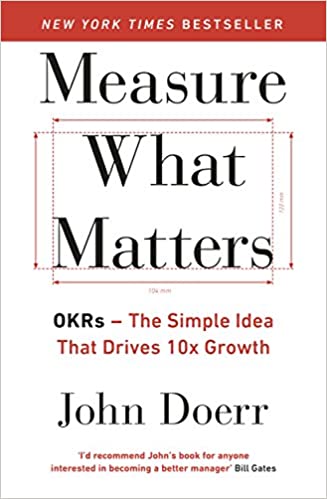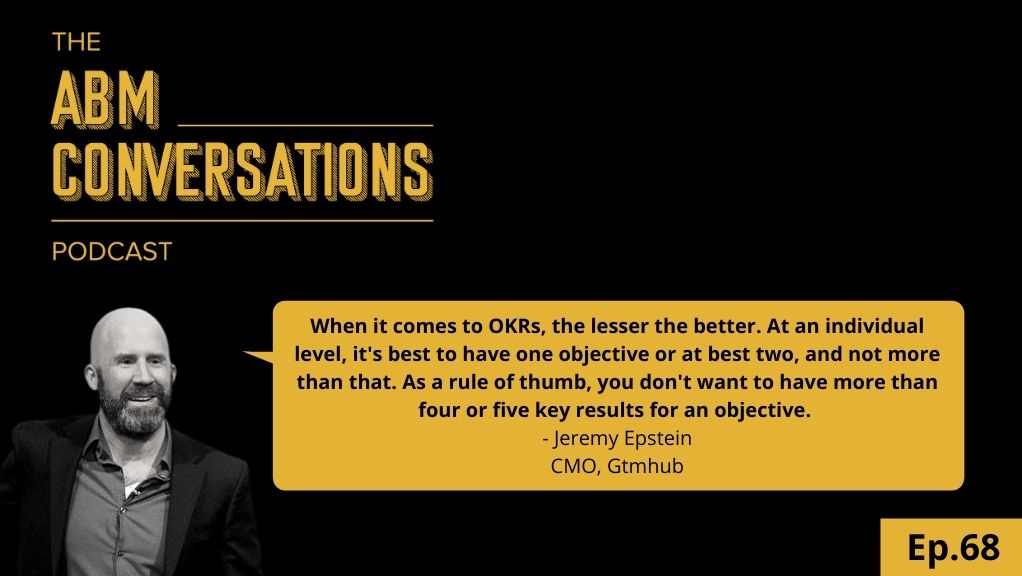OKR has been around since Andy Grove of Intel invented it back in the seventies, and it has its legacy about it, including Peter Drucker’s work. So it has a solid foundation. OKR is and will be the predominant goal system for the knowledge economy and the majority of organizations. You’ll most organizations using the OKR methodology and OKR tools by the end of this decade.
Let’s start with the basics. OKR stands for Objectives and Key Results. It is a goal system. Simply put, it means that you will achieve an objective, which a specific set of key results will measure.
If you are not already familiar with OKR, I recommend you to check out the book “Measure what matters” by John Doerr. It’s the Bible of the OKR industry.


The classic example is, say, you want to get in better shape. Well, that’s great. But what does that mean?
It could mean you will have lower blood pressure, or reduce weight by practicing for a marathon, so on and so forth. In short, the key results are the measurements assigned to help you understand what the achievement of the objective means. And it’s just a way to help you get clarity around what you want to accomplish and how you’re going to get it done. The best part is that it makes for a very effective way to help that clarity disseminate across the organization.
How is OKR methodology different from Balanced Scorecard (BSC) and other strategy execution methodologies?
OKR is an evolution of the balanced scorecard. You can use both BSC and OKRs in conjunction b. There are similarities in terms of –how we mobilize change in an organization through executive leadership, how we make strategy a continual process and make strategy everyone’s job, etc.
OKRs are all about aligning the organization to the strategy and translating that strategy into operational terms. There are also similarities in terms of the causes of failure. For example –lack of support and commitment from the senior management, or too few people involved, or the scorecard hasn’t been disseminated, or that it’s just a one-off thing you do once a year.
That said, there are probably five or six key differences between objectives and key results, and balanced scorecards.
The time frame for goal setting
One of the key differences when it comes to OKR is the time horizon for goal setting. When you go by the balanced scorecard methodology, the review tends to be periodical like, say, annually. There are no mandated check-ins. But OKR tends to have multiple check-ins from time to time. So, OKRs tend to set a rhythm or habit across your organization –more like daily meditation for your business.
Execution and accountability
The balanced scorecard gives you a holistic approach, with four perspectives: financial, customer, internal processes, and learning & growth. And in comparison, the OKR model keeps it simple, executable, and accountable. It focuses on your business’s most important thing in a given quarter or in that half of the year. So, you don’t need OKRs in each of the four perspectives. It’s about deciding what is the most important.
No dependency on external guides
The third difference is ‘t really that OKR provides a guiding framework. What I mean is, you don’t need other people to guide the framework. It is generally an open-source software or a methodology that people can evolve to or adapt.
It saves you from siloing and sandbagging.
The fourth one, in a BSC setup, the scorecard recommends that incentive and compensation programs be tied to strategic objectives, whereas OKR would suggest that they shouldn’t be. The point is that otherwise, you’re going to have people who are sandbagging.
Emphasizing balance
OKRs are not just about accountability but encourage feeding one’s outcomes into other parts of the execution cycle. And there’s a lot to unpack in terms of how success is measured. While BSC is the lagging metric (meaning what has already happened), and OKRs are current. OKRs are about the progression towards the set objectives.
So, it’s not about one framework being better than the other because many enterprises who use BSC tend to use OKR as a turbocharging effect to extend the value of their strategic approach to execution.
The right stage for the company to start adopting an OKR model
One of the sad truisms of OKR is that 72% of first-time OKR implementations fail. And that has nothing to do with OKR software. It has to do with the right level of commitment and the right level of recognition (humility) that OKR is not something you execute alone. And, to add to that, it’s not only okay but preferable to have an OKR coach. So, when you’re starting on your OKR journey, the first thing is you need to recognize that it’s going to take a while. It’s going to take 3-6 months or even nine months to build this new muscle.
If your organization has two or more people, there is no way that you’ll be able to set and OKRs without software. You can’t do it in Excel or a whiteboard or a PowerPoint. So, it’s not about what’s the right time to implement OKR, but about asking what’s going wrong.
For example –are you having a difficult time anticipating disruption to your business? Are you having a difficult time realigning your strategy? Are you having a difficult time adapting to execution?


We’ve all been through this crazy vortex in 2020, and it’s exposed the challenges for so many organizations where they realized that they could not move as quickly and nimbly as assumed. Companies realize the importance of having an OKR system in place, which could be the linchpin for rapidly shifting to meet emerging market/business demands or even recognize the conflicting initiatives happening across their enterprise.
So, it boils down to realizing that OKR is pretty much suitable for any company at any stage, as long as they recognize the need to put things in place and run it like a dynamic ecosystem.
How to set up your objectives and measure results?
It all starts with understanding the way your existing business ecosystem and the data you are capturing. So, when you outline possible key results, it’s about deciding how you want to define success. For some, it might be the share of brand-voice. For some others, it might be a brand awareness survey or the number of organic website visitors. So, the critical thing is you don’t want to abandon the systems that you already have in place.
The point is realizing that your data is somewhere within your martech ecosystem and finding a way to stitch together the data meaningfully. For example, suppose one of my personal key results is to reduce customer acquisition cost (CAC). In that case, all I need to do is link up the various sources through which the leads are generated and then analyze how to optimize your spending. And in that essence, there is no right or wrong objective or potential key results. But, what’s also true is that OKR can go only as far as what you want out of it.
Related resource: A free Google Sheets OKR tracking template by Michael Williams
Can you change a set OKR? Sure. It happens a lot, of course. But as a rule of thumb, you don’t want to do that. What you do as the leader says, these are the objectives I’m at. And then you turn to your team and say – alright, I’ve set these OKR right now, so what is it that you think you can contribute to getting there collaboratively. It works best when the OKR identification happens collaboratively based on your team’s strengths, the systems you might have, what your initiatives are, what to prioritize, etc.
We have this beautiful alignment where everybody on the team knows their role and how they contribute towards the larger goal with excellent transparency.
How many objectives can a company realistically have?
Well, like most good things in life –less is more. It’s less about what all you can do and more about what you need to do or must do. As a company, you can ideally have 3-4 objectives at the topmost organization level. But once you have four objectives, it’s pretty much enough. It’s a lot because it says you are focusing on four different things. As a rule of thumb, you can have three objectives at the top and break them down so that each person only has one.
And for the key results, you want to have at least three, but no more than five.


Holistically, you have one or two objectives with 3-4 key result areas. If you are aggressive, they may be three objectives, but not more than that.
Adoption gaps and why OKR tools fail
It all comes down to the organization’s culture and if the OKRs are meaningful to people based on their mission. Suppose your OKRs are not aligning to the corporate mission in a meaningful way. In that case, no one is going to care because it feels artificial or yet another organizational hypocrisy that you see so commonly.
Another critical factor is that the key results have to be challenging but not impossible. If they’re just way out there (like the atrocities some people do in the name of stretch-goals), you’re going to end up with a whole bunch of demotivated people. Because it feels –huh, what’s the point anyways?
Third point –not recognizing the accomplishment at the end of an OKR cycle. That’s straight forward which needs no explanation 🙂


Overall, when you start implementing OKR, make sure you have leadership buy-in and are clear about why you are doing it. It helps adoption as well as accountability. It’s also important to realize that OKR is not about being perfect.
The first time it’s about understanding that things will go wrong, that people will come short, but in a knowledge economy, which we’ve hyperspaced into over the last year or so, it’s okay to make mistakes. It’s okay to fail. It’s what you learn from that process. And OKR is to give you the most powerful framework on the planet.
And if the organization tries to get too aggressive by having too many objectives, you’re saying, let’s take everything we’re already doing and shove it into this OKR tool. That’s not what OKR is for.
And remember…
You have to spend the time. If it helps, have a coach, have some training. You have to be able to educate people on what it takes to create a good OKR. You need to know how everyone in your organization fits into the puzzle. Tools enable if you know where you want to be.
If not –a fool with a great tool is still a fool 🙂
